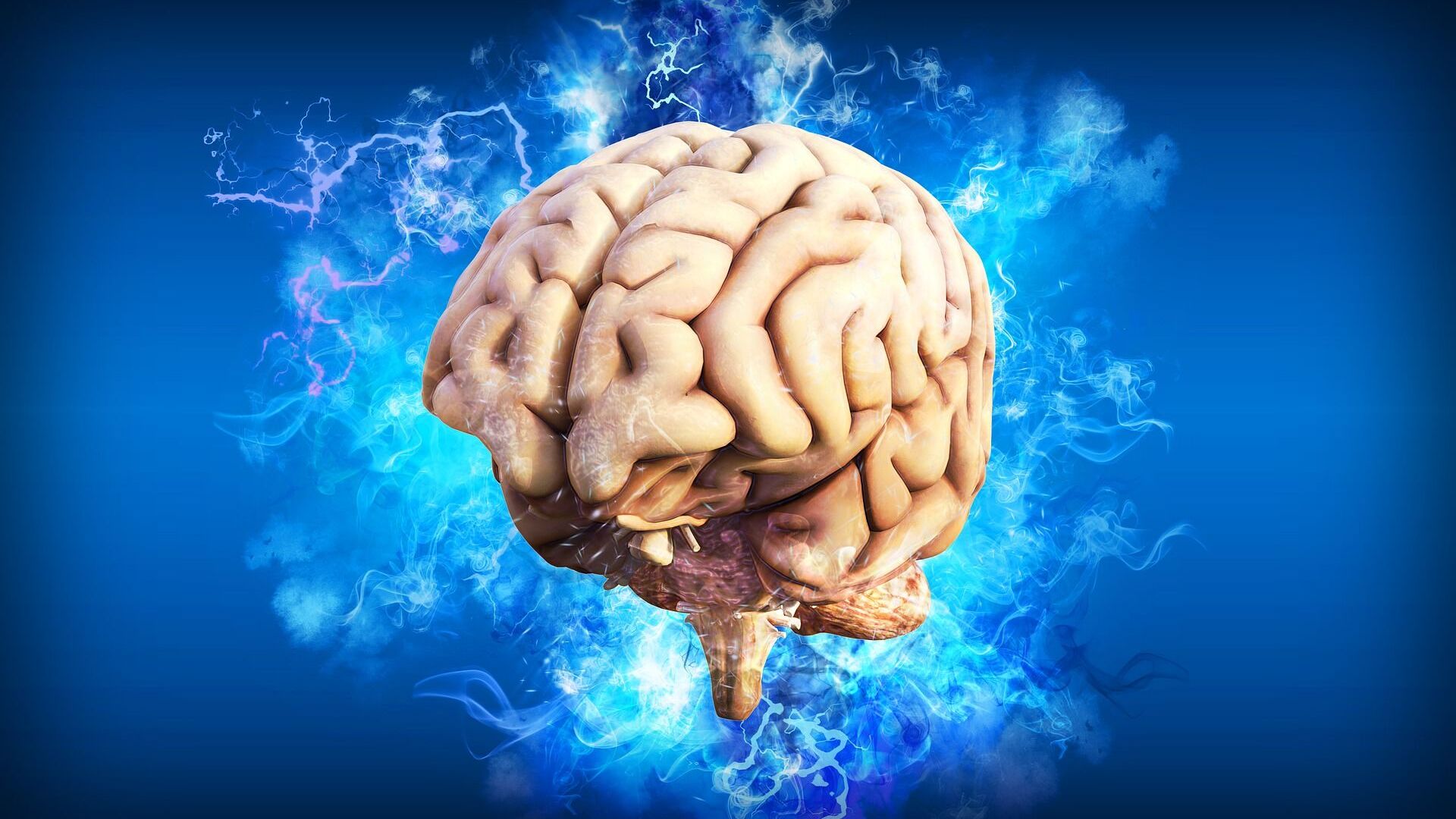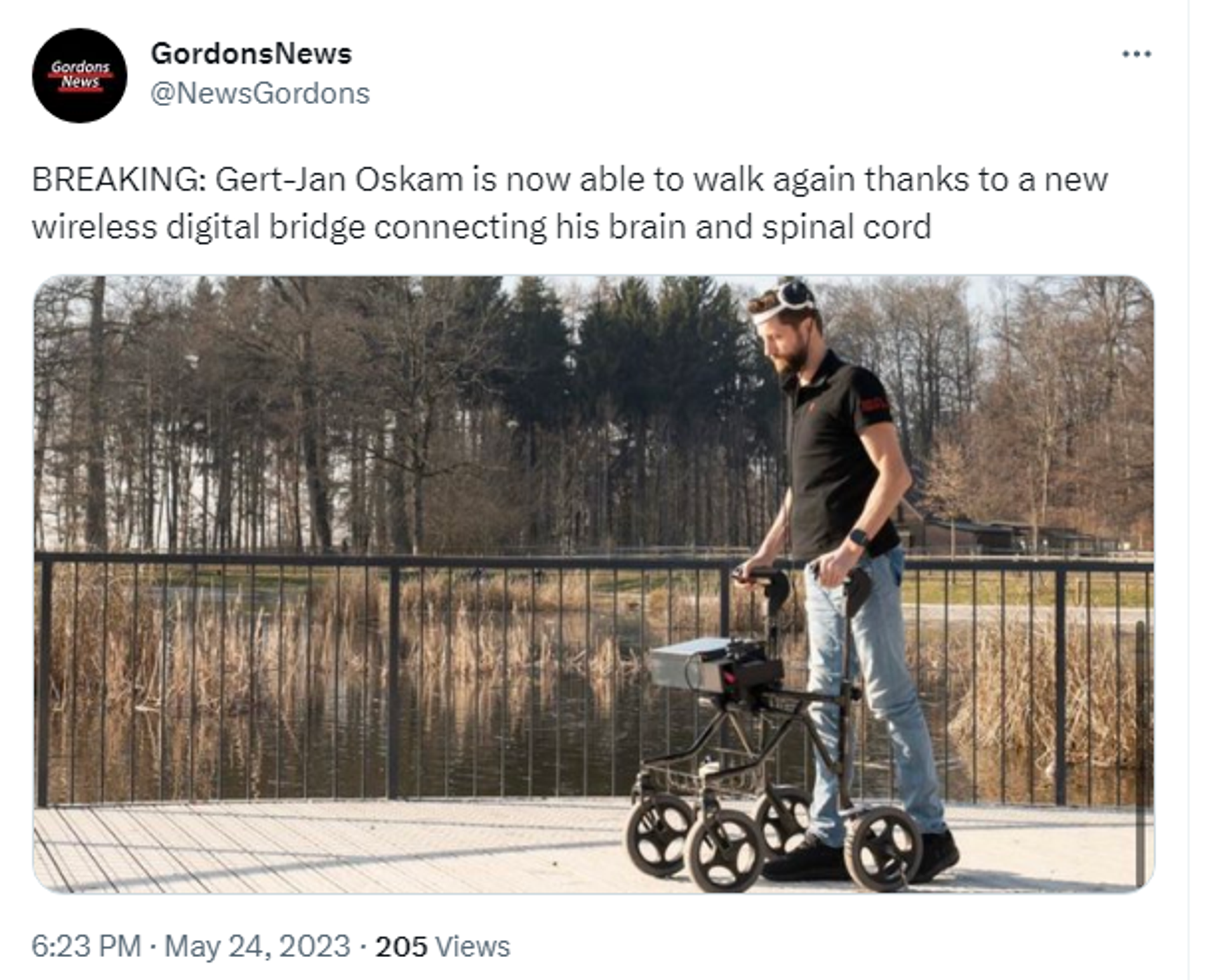https://sputnikglobe.com/20230525/paralyzed-patient-healed-via-digital-bridge-between-brain-and-spinal-cord---study-1110576410.html
Paralyzed Patient Healed via ‘Digital Bridge’ Between Brain and Spinal Cord - Study
Paralyzed Patient Healed via ‘Digital Bridge’ Between Brain and Spinal Cord - Study
Sputnik International
A new brain implant-related algorithm, which is still at a basic research stage, is expected to become a ray of hope for plenty of people suffering from spinal cord injuries.
2023-05-25T06:03+0000
2023-05-25T06:03+0000
2023-05-25T06:03+0000
beyond politics
netherlands
study
medics
brain
implant
research
https://cdn1.img.sputnikglobe.com/img/07e5/06/09/1083108360_0:36:1920:1116_1920x0_80_0_0_cae1927e45906d013285483f56b4345f.jpg
A “digital bridge” between the brain and spinal cord helped a patient regain his ability to walk after paralysis, a new study has pointed out.Gregoire Courtine, the study’s author and a neuroscientist at EPFL, a research university in Switzerland, told a US broadcaster that when he and his colleagues first met Oskam, “he was completely paralyzed, unable to take a step by himself without assistance.”The operation to restore the patient’s health was carried out in July 2021, when medics managed to install implants in his brain and spinal cord that pair with external devices to translate his thoughts into movement.“This brain–spine interface consists of fully implanted recording and stimulation systems that establish a direct link between cortical signals and the analogue modulation of epidural electrical stimulation targeting the spinal cord regions involved in the production of walking,” the study underlined.Oscam himself told reporters shortly before the publication of the study that “for 12 years I’ve been trying to get back my feet” and that “now I have learned how to walk normal, natural.”Professor Jocelyne Bloch, of Lausanne University, who carried out the delicate surgery to insert the implants, for his part told reporters that “it was quite science fiction in the beginning for me, but it became true today.”She explained that even though similar operations were many years away from being available to other paralyzed patients, the main goal was to get the system out of the lab and into the clinic as soon as possible.She was echoed by Harvey Sihota, chief executive of the UK charity Spinal Research, who touted Oscam-related development as "very encouraging.""While there is still much to improve with these technologies this is another exciting step on the roadmap for neurotechnology and its role in restoring function and independence to our spinal cord injury community," he added.
https://sputnikglobe.com/20230127/company-develops-ultra-thin-brain-implant-devoid-of-skull-drilling-1106773999.html
netherlands
Sputnik International
feedback@sputniknews.com
+74956456601
MIA „Rossiya Segodnya“
2023
Oleg Burunov
https://cdn1.img.sputnikglobe.com/img/07e4/09/0b/1080424846_0:0:2048:2048_100x100_80_0_0_3d7b461f8a98586fa3fe739930816aea.jpg
Oleg Burunov
https://cdn1.img.sputnikglobe.com/img/07e4/09/0b/1080424846_0:0:2048:2048_100x100_80_0_0_3d7b461f8a98586fa3fe739930816aea.jpg
News
en_EN
Sputnik International
feedback@sputniknews.com
+74956456601
MIA „Rossiya Segodnya“
Sputnik International
feedback@sputniknews.com
+74956456601
MIA „Rossiya Segodnya“
Oleg Burunov
https://cdn1.img.sputnikglobe.com/img/07e4/09/0b/1080424846_0:0:2048:2048_100x100_80_0_0_3d7b461f8a98586fa3fe739930816aea.jpg
brain implants, spinal cord injuries, paralyzed patient, new study
brain implants, spinal cord injuries, paralyzed patient, new study
Paralyzed Patient Healed via ‘Digital Bridge’ Between Brain and Spinal Cord - Study
A new brain implant-related algorithm, which is still at a basic research stage, is expected to provide a ray of hope to plenty of people suffering from spinal cord injuries.
A “digital bridge” between the brain and spinal cord helped a patient regain his ability to walk after paralysis,
a new study has pointed out.
The survey refers to Gert-Jan Oskam, a 40-year-old Dutch man, who suffered from a spinal cord injury as a result of a motor bike accident in China twelve years ago.
Gregoire Courtine, the study’s author and a neuroscientist at EPFL, a research university in Switzerland, told a US broadcaster that when he and his colleagues first met Oskam, “he was completely paralyzed, unable to take a step by himself without assistance.”
The operation to restore the patient’s health was carried out in July 2021, when medics managed to install
implants in his brain and spinal cord that pair with external devices
to translate his thoughts into movement.“This brain–spine interface consists of fully implanted recording and stimulation systems that establish a direct link between cortical signals and the analogue modulation of epidural electrical stimulation targeting the spinal cord regions involved in the production of walking,” the study underlined.
Oscam himself told reporters shortly before the publication of the study that “for 12 years I’ve been trying to get back my feet” and that “now I have learned how to walk normal, natural.”
“I feel like a toddler, learning to walk again,” he admitted in a separate interview with a Western news network. "It has been a long journey, but now I can stand up and have a beer with my friend. It's a pleasure that many people don't realize," Gert-Jan said.

27 January 2023, 18:59 GMT
Professor Jocelyne Bloch, of Lausanne University, who carried out the delicate surgery to insert the implants, for his part told reporters that “it was quite science fiction in the beginning for me, but it became true today.”
She explained that even though similar operations were many years away from being available to other paralyzed patients, the main goal was to get the system out of the lab and into the clinic as soon as possible.
"The important thing for us is not just to have a scientific trial, but eventually to give more access to more people with spinal cord injuries who are used to hearing from doctors that they have to get used to the fact that they will never move again,” Block emphasized.
She was echoed by Harvey Sihota, chief executive of the UK charity Spinal Research, who touted Oscam-related development as "very encouraging."
"While there is still much to improve with these technologies this is another exciting step on the roadmap for neurotechnology and its role in restoring function and independence to our spinal cord injury community," he added.





